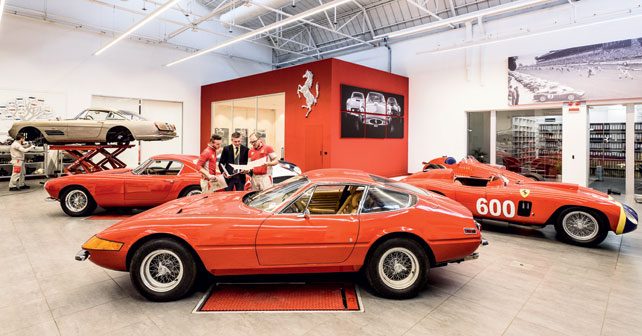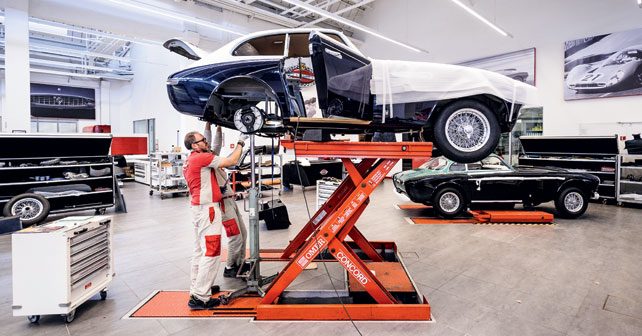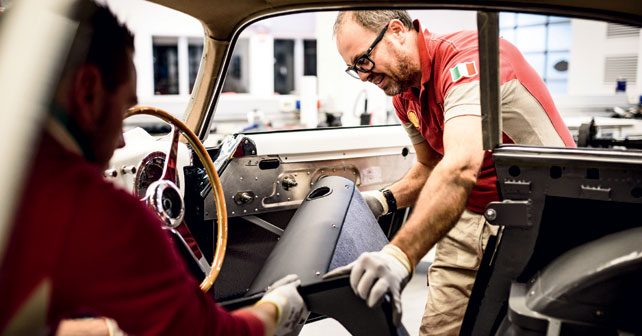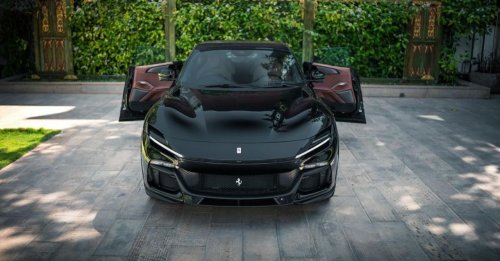
Ten years have gone by since Ferrari officially started its classic car restoration centre to look after its rich heritage. Located at the Maranello headquarters, this business is entirely focussed on Ferrari’s beautiful classics. Spread across 950 square meters of space, which was previously a foundry, the place has now been turned into a live museum – with Maranello’s masterpieces, which are sold at auction for millions of dollars, being given some TLC. Needless to say, it’s extraordinary to see these gems undergoing open-heart surgery in front of your eyes. A ‘classic’ example of the kinds of machines that make their way here is the 290MM Scaglietti, which ran at the Mille Miglia in 1956 with Juan Manuel Fangio at its wheel. It was sold at auction in New York in December 2015 for a whopping sum of over 28 million dollars, and has recently undergone a full restoration at Maranello.
FOLLOWING IN THE FOOTSTEPS OF THE GERMANS
The Ferrari Classiche department was the brainchild of the firm’s former leader, Luca Cordero di Montezemolo, and former F1 boss, Jean Todt, while observing what Mercedes Benz was doing with their classic car restoration program. In order to resurrect its classic cars correctly, they have a huge treasure trove of records stored in the library – which is deep inside a bunker in Maranello. And this literature can be used to trace the full range of features on each and every machine ever manufactured in Maranello. And so, ten years ago, this department became the base for accurate restorations – helping owners from around the world to keep their beauties perfectly faithful to their origins. So far over 70% of all Ferraris ever produced are still on the road – so business is pretty good.
Currently, there are roughly 300 classic Ferraris that are certified by the Ferrari classic department every year. Among these, some need more significant work than others – and these are the ones that are brought to the Maranello premises to start their restoration in earnest. We met the man who currently heads the department, Luigino Barp, and he revealed some intriguing stats about the business.
Barp has practically worked in each and every building within Ferrari’s headquarters at Maranello – from prototype testing to assistance systems to foreign markets, he’s seen and done it all. And, presently, he’s also in charge of technical services. “We are the only ones in the whole world to keep a complete record of the whole range of cars we produce with full details, hand-written by our mechanics. And I personally know these men. So, whenever I see their notes, I feel a lump in my throat.”
In his team, he’s got a workforce of twelve people, including engineers, mechanics and upholstery experts. Another seven are the workers who take care of certification and documentation issues. Surprisingly, their average age is quite low – only a few have grey hair. “They are the best employees we have in our team,” Barp claims, with a satisfaction that’s sort of typical of the head of the family. “These are the sort of employees who you have to send back home forcefully at the end of the day, since they just won’t stop working. That’s how passionate they are about their job.” As small as this team may be, it’s a group of professionals who can rebuild an engine of the forties from scratch. Sure, they might be pieces belonging to the company’s illustrious history, but, from a technical point of view, they’re mind-bendingly complex – especially the V12 engines.
There are also some researchers who check the details of a car’s body, interior and frame using old photos and designs kept in the archives so as to get a full understanding of the machine. Thanks to prototyping, today, Ferrari’s Classiche department is able to reconstruct everything. Of course, it could bring back any car to life by using new components, but that’s against the company’s policy – the division tries to repair or reconstruct original components as much as possible.
At this very moment, Barp turns our attention towards a blue 1957 250 GT ‘Tour de France.’ He tells us that, since it’s in extremely good condition, the owner has even asked for the wires of the new electrical system to be inserted in the original sheaths – which is quite painstaking work.
All the restoration work is first evaluated along with the car collector. Sometimes the body of a car has to be done from the ground up since it’s undergone several alterations in the past. However, there are a few cases when these machines have been looked after so well that very little is required.
How do they find out if a car is original? Well, the Classiche department has set up a scientific board that evaluates each machine. Apart from Barp, the board is led by engineer Piero Ferrarima, Leonardo Fioravanti, who takes care of the aesthetics, and Maurizio Rossi (ex head of Ferrari’s experimentation unit). If they find a particular model to have undergone too many touch ups, it won’t be approved and accepted for restoration. But, once a car is fully done, and provided with a warranty by Ferrari Classiche, the final result is a car that’s worth up to 30% more than before.
Workshop & Museum
This is what you’ll find in a small portion of the 950 square meter facility dedicated to Ferrari’s classic models in Maranello. In the foreground, you can see the stunning 365 GTB/4 Daytona, while on the right is the iconic 290 MM – which ran at the Mille Miglia in 1956 with Fangio behind the wheel.
Refined manpower
Ferrari’s classic department is currently headed by Luigino Barp (above), who has been part of the firm for the last thirty years. Below you can see a Ferrari 212 on a lift, and on the facing page a V12 engine being restored to look as good as new.
Complete process
On the facing page, you can see a differential being restored. And, below, you can see that even all the upholstery and leatherwork is done right here in Maranello. Only the bodywork is done off site, since there are no sheet metal workers on the premises.
© Riproduzione riservata
Also Read: Driven: Ferrari F12 TDF































Write your Comment